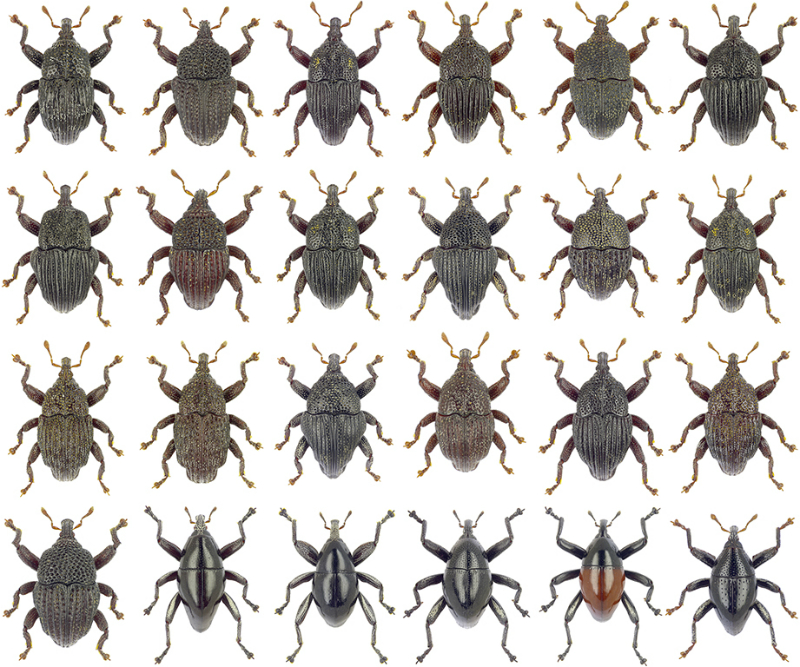Hiding in Plain Sight: 24 New Beetle Species Discovered in Australia

This story was updated at 3:52 p.m. ET on Jan. 28.
Lying among hundreds of beetle specimens in museum collections across Australia was a treasure trove of unidentified weevils, including as many as 24 new species, according to a new study.
Most of the beetles were collected almost 30 years ago, but they remained unnamed until Alexander Riedel, a curator at the State Museum of Natural History Karlsruhe, and Rene Tänzler, a biologist at the Zoological State Collection in Munich, both in Germany, started cataloging them and stumbled across 24 new species that have now been added to the weevil genus Trigonopterus.
All of the newly described weevils are restricted to small areas of tropical rainforests along the east coast of northern Queensland, Australia. Part of the reason for their isolation may be their lack of wings, which has prevented them from spreading, the researchers said. The new beetle species are also easily overlooked because they live on fallen leaves and dead wood, feeding on leaf litter, bits of palm fronds and other rainforest plants, basically recycling plant material, the scientists added. [Image Gallery: Shimmering Metallic Beetles]
"There are millions of species on our planet with whom we co-exist," Riedel told Live Science. "What's most exciting for me is to make a few of these new forms of life visible to others as well. And, of course, this has practical implications for national parks and so on, because if you realize that there are lots of species endemic to the region, then there is special value in protecting it."
Still, it is not unusual to discover this many new weevil species in Australia, Rolf Oberprieler, an entomologist at the National Research Collections in Canberra, Australia, who was not involved in the new study, told Live Science in an email.
There are hundreds more beetle specimens in the Australian National Insect Collection, and Oberprieler estimates that the real number of beetle species in Australia may be more than 20,000 — five times as many as have been cataloged.
Sign up for the Live Science daily newsletter now
Get the world’s most fascinating discoveries delivered straight to your inbox.
Tropical rainforests are known for their high biodiversity, and many contain species that are unknown and not yet named by scientists. Insects, and especially beetles, make up a large proportion of this undiscovered life on Earth, Riedel said. He has been cataloging Trigonopterus beetles from rainforests across Australia, Indonesia and New Guinea.
It is likely that Trigonopterus weevils originated in Australia because it is the oldest landmass in the region, Riedel said. This is why putting a name and face to as many of the beetles in the area as possible is important to the study of their evolution.
However, the process of studying and cataloging Trigonopterus weevils is difficult.
"They are small, and they all look the same!" said Chris Reid, an entomologist at the Australian Museum in Sydney who studies a different family of beetle and was not involved in the new research. "Normally, they are folded up very tightly and pretend to be seeds, and are very hard to dissect."
Riedel and his colleagues had to depend on both dissection and DNA sequencing to name the new species. But there are many more beetle specimens that they had to omit because either the morphology was too similar or the researchers did not get the opportunity to sequence the beetle's DNA yet. The researchers hope that their study will spur additional fieldwork needed to arrive at a more comprehensive understanding of the Australian Trigonopterus fauna and their evolution.
The findings were published today (Jan. 21) in the open-access journal ZooKeys. High-resolution photographs of each species, along with its scientific description, also will be uploaded to the Species-ID website, the researchers said.
Editor's Note: This story was updated to correct Chris Reid's field of study. He researchers a different family of beetle, not a different genus of weevil.
Follow Knvul Sheikh on Twitter @KnvulS. Follow Live Science @livescience, Facebook & Google+. Original article on Live Science.









